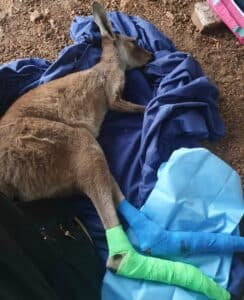Built for digging and perfectly attuned to their environment, wombats keep Australia’s soils healthy and our ecosystems balanced. They’re also deeply loved by the public — but in many parts of the country, they can still be killed legally. Too often, it’s wildlife carers who are left to deal with...
by Shane Williams – Bridgetown Wildlife Rescue
Smokey came into care not long after the terrible fires in Bridgetown began, in February 2022. Thankfully he was not found in the fire zone, but by some young children riding their bikes on a bush track close to their home. Smokey had been trying to flee the fires with his mother, and got caught up in a wire fence. The kids found him hanging upside down and crying for his mother. They asked their parents to come look, but everyone had to keep vigil at home in case the fires changed direction.
 Smokey with his wounds treated, exhausted from hanging in a fence upside down for hours.
Smokey with his wounds treated, exhausted from hanging in a fence upside down for hours.
The children knew a lovely man named Sam in the neighbourhood, so they rode to his home to ask for help. Sam responded immediately, put the children’s bikes in the back of the Ute and drove toward the fire zone with the kids giving directions to Smokey. Sam carefully cut the wires, that by this time had dug right down to the bone. In all the confusion, amid the smoke was Smokey’s mother, watching her joey being cut out of the fence. Smokey was afraid and crying, and his mother gave comforting coughs to her little joey – when she did, he stopped struggling and allowed Sam to continue cutting the wires that were clamped around his legs.
Finally, Sam had cut Smokey free. The joey could not move his legs as Sam placed him in his big woollen jacket. Smokey’s mother kept her distance and was still comforting her joey with the sound of her voice. I am sure that she knew Smokey was being helped. She watched Sam drive away with her little boy, it would be the last time she would see him.
On arrival at Bridgetown Wildlife Rescue, I directed Sam to the medical pen. The children were chatting to me how wonderful Sam was for rescuing the joey, excited to know the part they had played in the rescue. I quickly administered first aid and pain relief and made the joey as comfortable as possible. I asked the children to name the joey, and so his name became Smokey.
 Smokey after having his physiotherapy and bandage change.
Smokey after having his physiotherapy and bandage change.
The next day I drove Smokey to the nearest vet clinic with an x-ray machine, 70 kms away. Thankfully there were no breaks or fractures, but there was extensive nerve damage to Smokey’s spinal cord. It would take many months of intensive rehabilitation and physiotherapy to get Smokey to stand again. With that, bandage changes every three days for eight weeks, until his deep wounds to both legs were healed, accompanied by daily penicillin to help with the infection.
Smokey was a delightful little boy to have in care. He had a very gentle, sweet nature, and took to being in care immediately. The other joeys in my care would lay around his pen and comfort him, and Smokey became part of their mob through the chicken wire that divided them.
 Smokey laying with his mob.
Smokey laying with his mob.
It took two months for Smokey’s wounds to heal and three and a half months of physiotherapy twice a day to get Smokey to stand and use his legs. The first day that Smokey could join his new family in the garden was such a joy. The joeys accepted Smokey immediately, they all came up to him to greet him, and touch noses like they did everyday through the fence. Smokey is still with the mob and is extremely popular. He will be released with his mob next April on the Bridgetown Wildlife Rescue property, a 430-acre site bordered by the gigantic Wilga Forest.
I fell in love with Smokey. I cannot thank Humane Society International enough for providing the funding for his vet bills, medication and expensive antibiotic creams to treat his wounds. Another life saved because of Humane Society International’s kindness.


